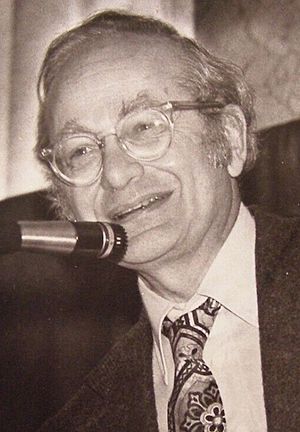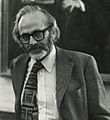David Hubel facts for kids
Quick facts for kids
David Hubel
|
|
|---|---|
 |
|
| Born |
David Hunter Hubel
February 27, 1926 Windsor, Ontario, Canada
|
| Died | September 22, 2013 (aged 87) |
| Nationality | American-Canadian |
| Alma mater | McGill University |
| Known for | Visual system |
| Spouse(s) |
Ruth Izzard
(m. 1953) |
| Awards |
|
| Scientific career | |
| Fields | Neurophysiologist |
| Institutions |
|
David Hunter Hubel (born February 27, 1926 – died September 22, 2013) was a Canadian scientist who studied the brain. He was a neurophysiologist, which means he focused on how our nervous system works. Hubel is famous for his research on how our brain sees and understands the world around us. He shared the 1981 Nobel Prize in Physiology or Medicine with Torsten Wiesel for their amazing discoveries about how our visual system processes information. The prize was also shared with Roger Sperry for his own research.
Contents
Hubel's Career and Awards
David Hunter Hubel spent most of his career as a professor at Harvard Medical School. He was a very important researcher in the field of neurobiology, which is the study of the nervous system.
In 1978, Hubel and his research partner, Torsten Wiesel, received the Louisa Gross Horwitz Prize. This award recognized their important work in understanding how vision works.
Hubel passed away in 2013 due to kidney problems.
Why Hubel Won the Nobel Prize
Hubel and Wiesel received the Nobel Prize for two main reasons:
- They studied how our visual system develops, especially during childhood. They looked at parts of the visual cortex in the brain that receive signals from either the right or left eye.
- They also discovered how the brain processes signals from our eyes. This processing helps us see things like edges, movement, depth (how far away things are), and colors. These are like the building blocks that help us understand everything we see.
How Our Brain Sees: Some Details
How Brain Cells Detect Features
In 1959, Hubel and Wiesel did a famous experiment. They placed a tiny electrode (a small wire) into the visual part of an anesthetized cat's brain. Then, they showed patterns of light and dark on a screen in front of the cat.
They found that some neurons (brain cells) became very active when they saw lines at a certain angle. Other neurons responded best to different angles. Some cells even reacted differently to light lines compared to dark lines. Hubel and Wiesel called these special neurons 'simple cells'.
They also found other neurons, which they called 'complex cells'. These cells could detect edges no matter where they were in the cat's vision. They could also detect movement in specific directions. These studies showed how our visual system builds a complete picture of what we see from simple features.
How Flexible Our Visual Cortex Is
Hubel and Wiesel also did important work on how flexible our brain's visual part is. This flexibility is called cortical plasticity.
They did an experiment where they prevented kittens from using one eye for a short time. They found that the parts of the brain that normally got signals from the unused eye were taken over by the other eye.
These kittens did not develop the ability to use both eyes together for binocular vision, which is important for seeing depth. Hubel and Wiesel's experiments showed that how our eyes become dominant (one eye being stronger) happens early in life. This discovery helped doctors better understand and treat several childhood vision problems.
Related pages
Images for kids
See also
 In Spanish: David Hunter Hubel para niños
In Spanish: David Hunter Hubel para niños


